Overview
Casas de Hitos ('house of milestones') is normally referred to by visiting birders as the "ricefields". Although the ricefields extend from Madrigalejo to Badajoz, over 100km, this small area is the most visited and documented by visitors. An important area for a large proportion of the visiting 70,000 or so Common Crane overwintering in Extremadura. This area is under threat, as the Government of Extremadura plan to build 100 hectares of solar farm here, along with 50km of high tension overhead cables and pylons to the distribution centre at Valdecaballeros.
Birds
Common Crane is to be found here in huge numbers from October to early March. White Stork overwinter in large numbers here, preferring these wetlands to the long migration to Africa. Bluethroat winter here in large numbers in the overgrown ditches surrounding the managed fields, and are easily found by listening to their snip snip call from the reeds. Huge concentrations of passage waders stop here to refuel for a few weeks every autumn and spring, including Black-tailed Godwit, Ruff, Little Stint, Temminck's Stint, Wood Sandpiper, Pied Avocet, Dunlin and Eurasian Golden Plover. Collared Pratincole and Little Ringed Plover breed here when the fields are dry. Cetti's Warbler, Red Avadavat, Common Waxbill, Zitting Cisticola and Melodious Warbler are numerous. Great and Little Bustards can be seen here, but the tall vegetation makes it rather difficult, and Black-bellied Sandgrouse often give good views.
Rarities
Kentish Plover have bred here since 2008, a first for Extremadura. Casas de Hitos is an excellent place to see Black-shouldered Kite that breed and feed here.
Check-list
Little Grebe, Great Crested Grebe, Black-necked Grebe, Great Cormorant, Little Bittern, Black-crowned Night Heron, Squacco Heron, Cattle Egret, Little Egret, Purple Heron, Grey Heron, Black Stork, White Stork, Eurasian Wigeon, Gadwall, Common Teal, Mallard, Northern Pintail, Garganey, Northern Shoveler, Red-crested Pochard, Common Pochard, Ferruginous Duck, Tufted Duck, White-headed Duck, European Honey Buzzard, Black Kite, Short-toed Eagle, Western Marsh Harrier, Hen Harrier, Montagu's Harrier, Common Buzzard, Booted Eagle, Lesser Kestrel, Common Kestrel, Peregrine Falcon, Common Quail, Water Rail, Common Moorhen, Eurasian Coot, Little Bustard, Great Bustard, Common Crane, Pied Avocet, Black-winged Stilt, Stone-curlew, Collared Pratincole, Little Ringed Plover, Kentish Plover, Eurasian Golden Plover, Northern Lapwing, Dunlin, Ruff, Common Snipe, Black-tailed Godwit, Common Redshank, Black-headed Gull, Gull-billed Tern, Whiskered Tern, Black Tern, Pin-tailed Sandgrouse, Great Spotted Cuckoo, Common Cuckoo, Eurasian Scops Owl, Little Owl, Short-eared Owl, European Bee-eater, European Roller, Eurasian Hoopoe, Greater Short-toed Lark, Calandra Lark, Thekla Lark, Sand Martin, Barn Swallow, Red-rumped Swallow, Tawny Pipit, Water Pipit, Meadow Pipit, Bluethroat, Cetti's Warbler, Zitting Cisticola, Moustached Warbler, Common Reed Warbler, Great Reed Warbler, Melodious Warbler, Western Olivaceous Warbler, Dartford Warbler, Sardinian Warbler, Blackcap, Iberian Chiffchaff, Penduline Tit, Iberian Grey Shrike, Woodchat Shrike, Common Starling, Spanish Sparrow, Reed Bunting
Other Wildlife
Egyptian Mongoose can be seen regularly here, usually in small family parties of 5 or 6.
Site Information
History and Use
Rice has been grown is Spain for over 1200 years, but the area here was developed in the 1950's, when the large rivers were dammed, providing the vast amounts of water required for the irrigation of the dry fields.
Areas of Interest
The large pool, or charca, to the north of the entrance to the Casas de Hitos complex holds many wintering Greylag Goose, Little Egret, Cattle Egret, Grey Heron, Shoveler, Pochard, Gadwall and Pintail.
Access and Facilities
Take the road from Zorita to Madrigalejo, past the entrance to Embalse de Sierra Brava, past the old railway station, and along the line of Eucalyptus lining the main road. At the end of these trees is the Pension Mayve, turn left here, through about 4 km of open grassland and oak wood, and you will come to the rice fields of Casas de Hiotos.




